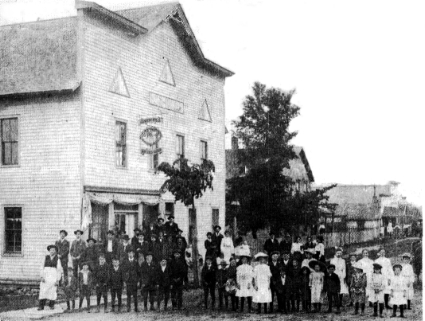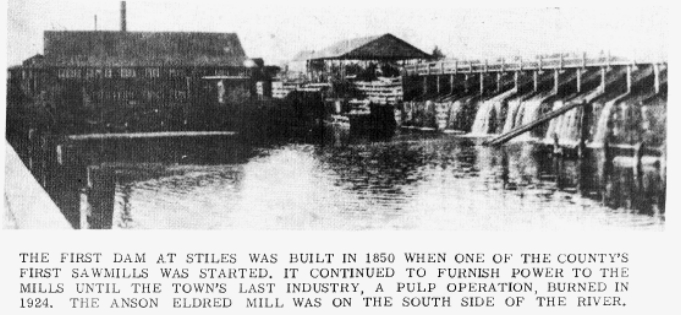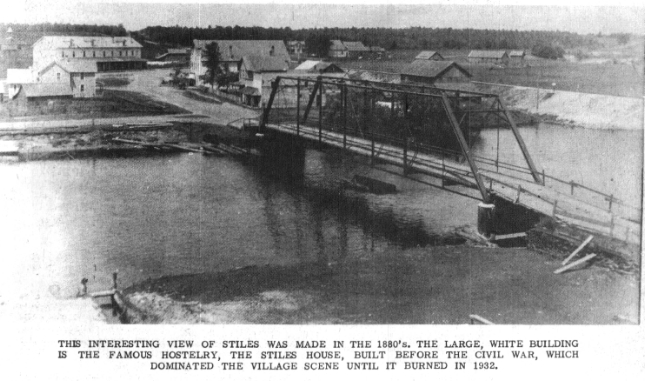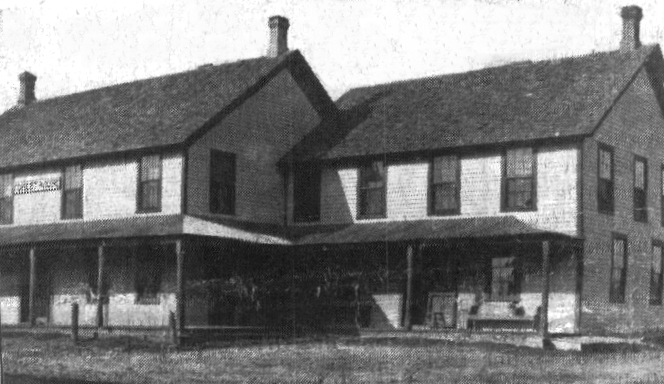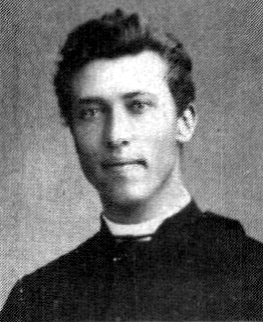| Oconto County Reporter
November 11, 1971 The Glory that Was Stiles
Where was this social center of the early days? In a flourishing settlement on the banks of the Oconto river called Stiles. The history of Stiles is a fascinating one. It’s the story of a community that rose to the heights on a footing of northern pine, died an untimely death within a generation, was revived by a railroad, and then suffered a second demise when fires burned down the mills and much of the rest of the town. The story begins in 1839 when the settlement was first surveyed, and when the town of Stiles included most of present Oconto county north of Suamico and Pensaukee, and west of Oconto. In 1850 Merrick Murphy obtained a deed for land from Thomas Lindsey, built a dam across the Oconto river, and started a logging operation. But the boom didn’t really start until a year later when an enterprising lumberman named Anson Eldred came along and bought himself a partnership with Murphy. Eldred, who at the early age of 22, already had a lumber yard in Milwaukee, started his lumbering operations in Wisconsin and southern Michigan through a series of partnerships in 1842, and in a short time became possibly the largest land owner in Oconto county.
In 1856 Anson formed a partnership with his brother, Elisha, and Uri Balcom of New York, but it was short-lived, ending in two years when Balcom went to Oconto to join with Devillo Holt in a lumbering operation, the latter was then starting there. John Nelligan, another colorful figure on the lumbering scene, was also at Stiles during this period. The majority of the hands at the Stiles mills were Indians, among them Chief Machickanee of the Menominees, a colorful figure who, on ceremonial occasions, wore a Prince Albert coat, high hat- and no trousers. By pitching his tepee during hunting season at the spring south of the river, Chief Machickanee succeeded in having that body of water named for him, and in time, an entire forest. Indians continued to be a common sight in the settlement for many years to come, as they traveled down the rod to their burying ground at Leighton. For the most part, the settlers and Indians got along amicably, but one unfortunate example of “man’s inhumanity to man” found its way into the Reporter’s pages of a November issue in 1881. To quote: "On Sunday last while a band of Indians composed of a chief, 10 or 12 squaws and an aged Indian, who was carrying a sick child, were passing through this place (Stiles), the latter was brutally assaulted by a band of ruffians. His rifle was taken from him, and after being pursued by a hooting and yelling mob, he was finally taken from his horse and, with the sick child in his arms, was dragged about on the ground. With such abuse at this we need not wonder that the Indians are a rebellious people." * * * As a general rule, however, life in the community was good. A favorite pastime of the villagers on warm evenings was to sit along the river bank, watching the water and sky turn luminous from the mill waste burning in an “open fireplace” on the island. And in the spring, with the return of the lumberjacks from the woods, the town vibrated with their exuberance as they tramped along the wooden walks or celebrated their release from the winter’s hard work in the bars of such hotels as John McIvers Forest House and Eldred’s Stiles House. STILES BECOMES A GHOST TOWN After a quarter century of envious prosperity, things began to go bad for Stiles as Anson Eldred started looking elsewhere for mill sites. In 1873 he built a mill and dams at Little Suamico, and in 1876 he bought out the England, Taylor and Company mill on the south side of the river in Oconto. (Area across from present Jefferson school – Editor). He also had a partnership with his son, Howard, in a mill at Fort Howard, and had mills at Little Sturgeon and in Florida. The Stiles mill was no longer his main operation, and its neglect began to show in the town. By 1881 the settlement had become a ghost town. When in that year, a fire destroyed one of Eldred’s boarding houses at Stiles, built in 1857, it was reported there were only two families left in town “to guard the forsaken property”. Noted the Reporter: "For nearly four years now, none but an occasional traveler or log driver have occupied the deserted buildings."
"A railroad boom has set in and we are going to enjoy it while it lasts, be it permanent or transient, and we hope to see Stiles once more a live town. It has slept long enough, unless it is going to sleep the sleep that knows no waking. The railroad surveying party has passed through here and left a row of stakes behind. Whether they will get lost in the wilderness north of us and never return, I don’t know, but we will enjoy those stakes while we have them. Anything for a change." Meanwhile a delegation of prominent Oconto citizens, including Holt, Balcom, Mayor William Young and O. A. Ellis, made a trip to Milwaukee in an attempt to talk the railroad people into laying the track through Oconto, claiming: "In the way of freights and passengers the company would get more money from this city in a month than it would from Stiles in a year." That was in January, but in February it was definitely established that the route would run through Stiles. The ghost town came alive. A new town site was laid out and new mills erected under the company name of Eldred and Son. By 1882 a post office was established at the village and named "Eldred", with Howard Stiles Eldred appointed postmaster. "It could not be called Stiles", said a March 4 Reporter item, "for the reason that an office by that name already exists in the town of Stiles." The regrowth that the railroad brought is shown in this 1887 Reporter description of Stiles: "Robert McIvers has a fine big hotel at Stiles Junction, and near the depot is a hotel and saloon kept by James Hurley. Next door is the saloon of Pat Hurley, and next to that, the saloon and meat shop of Joseph McClusky. Further on is the shop on Henry VanVagel, the village shoemaker. "Anson Eldred & Son has a planing mill across the lower bridge, and also owns the community’s largest hotel, the Stiles House. The houses are chiefly built by the company and look so much alike we were told there’s many a man has his keyhole fumbled around by his neighbor long after he is in bed. At the west end of the village is the Forest House (the old Luby Hotel) operated by John McIver." And, in 1896, the paper reported: 'The village of Stiles is also possessed of attractions. Besides the Anson Eldred Company mills, it may boast of a superior creamery, and a large herd of beautiful Jerseys. The creamery is one of the best in northern Wisconsin and is under the capable supervision of J. W. Whipple. Its daily production averages 225 pounds of butter." THE DOWNHILL RIDE BEGINS AGAIN Things went well for Stiles until the dawn of the Twentieth
Century. But fate seemed to have a personal vendetta with the plucky
community that had died once, and been reborn again. And if there
is little now to show of the "glory that was Stiles", it can be blamed
on the demon fire.
It began in 1900 when fire swept over the section of the village where the Eldred buildings stood, destroying the company store, barns and many workers’ houses. Then, in 1904, the Forest House, then owned by W. J. Classon, burned down, and another old landmark was gone. Howard Eldred continued to operate the sawmill until
1910 when the last log was sent through. The planing mill and yards
closed two years later with a final wailing blast of the whistle " let
off by Joseph Bergemeier " and the mill workers and their families began
to move away. Some, however, found work when the mill was converted
to a pulp operation. Eldred Klauser was secretary of the company.
But fate, with fire her handmaiden, wasn’t through yet. On March 12, 1918 sparks from a passenger train passing through the village at midnight started a fire that carried off the railroad station and coal dock. The final blow fell on a warm summer’s night in 1924, spelling finis to the last remaining industry in the village. The “obituary” was reported under a June 26 dateline by the Reporter: ELDRED MILL BURNS AT STILES "Ole B. Olsen, 67, oiler, lost his wife and a loss of between $70,000 and $80,000 was suffered by the Anson Eldred Company of Stiles Saturday when the pulp mill was destroyed by fire." After that, no one looked for another miracle and one by one the people moved away until only eight or nine families remained. On March 3, 1927, the Reporter had still another unpleasant happening to relate from Stiles. To quote: “A reward of $500 is offered by the Anson Eldred Company for information leading to the arrest and conviction of the parties who attempted to rob, and who set fire to the U.S. post office and general store at Stiles Saturday night. Frank McAllister, awakened by the siren of the burglar alarm, notified Eldred Klauser, who arrived to find the store a mass of flames. As the village has no fire fighting equipment, a call was put into Oconto, but Bert Harris and his men arrived too late to save the building. But there was still the Stiles House, that famous hostelry erected before the Civil War, a three-story wooden structure with 40 rooms, and a grand suite reserved for the mill owners. Now, since there was no need for it any longer as a boarding house for mill workers, it was redecorated and converted into a “country tea room” and summer hotel in 1928. With cities like Milwaukee and Chicago growing noisy and congested, the resort at Stiles was not at a loss for customers as people came by car and train to the peace and beauty of the Machickanee forest area. But that, too, was to be a shortlived boon to the village. In February of 1932 a conflagration that threatened for a time to burn down all of the village, swept away the historic Stiles House. A SECOND RESURRECTION It is now 125 years since Anson Eldred started his town and almost half a century since the old mill burned. But Stiles has something going for it that even the loss of industry and the devastation of fire could not negate: a scenic woodland location on the river. And today, instead of being a ghost town, the population of Stiles is steadily growing and now numbers about 400. The big business in Stiles now is in real estate, as more and more “big city” people buy lots for homes and cottages. And many who before were only seasonal residents, are now retiring permanently to their summer homes. To accommodate the migrating public, Stiles now has
a half-dozen stopping-off places, the Alamo Club, the Chicken Shack, the
Machickanee restaurant and filling station, Truckey’s tavern and restaurant,
Boot’s club and the 141 Club. Stiles also has a flourishing florist
business on the river road, as in the village an upholstery shop operated
by Frank Ellner. Just recently, for the first time in its history,
it acquired a resident medical professional of Dr. John Younger, dentist.
In spite of the frequency of fires, and mass migrations from the town, two "institutions" have survived from Stiles’ past. One is St. Patrick’s Catholic church, which, with its rectory and church cemetery, dominates the hill north of the river. The other is Mrs. Alice Connors’ general store, the focal point of the town, not only because it is the only store there, but also because demonstrated affection and concern Alice has for her town and its people. The business started with Alice’s father, Eugene Van Lanen, one of the town’s early residents, who arrived with his parents as a boy. About 1895 Mr. Van Lanen bought Pat Curley’s place and renovated it into a dance hall and tavern. When the building burned in the 1907 fire, he moved from the highway into the town, where he build a two-story brick hotel and tavern. While the Eldred mills were running and lumberjacks
were an important part of the town’s population, the business flourished.
But then prohibition came along in the 1920’s, the mill burned in 1924,
and business went downhill. When the Eldred Company store burned
in 1927, Van Lanen turned his operation in to a general store.
|
